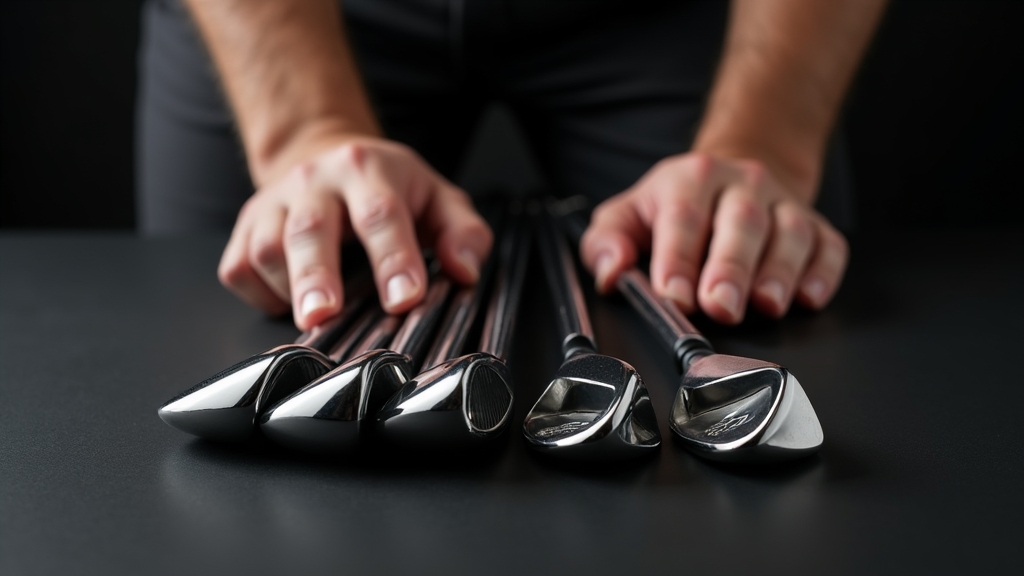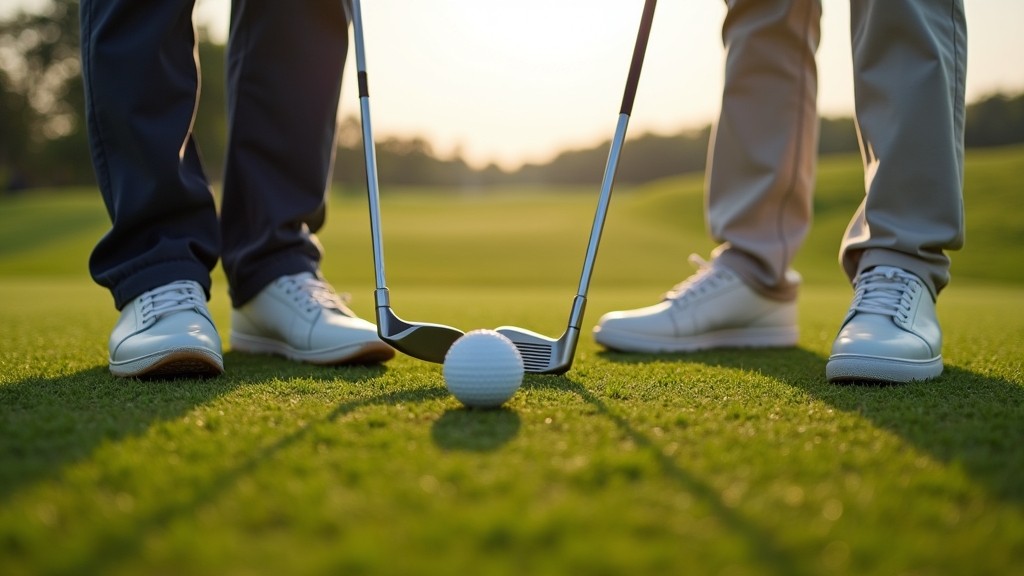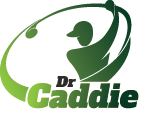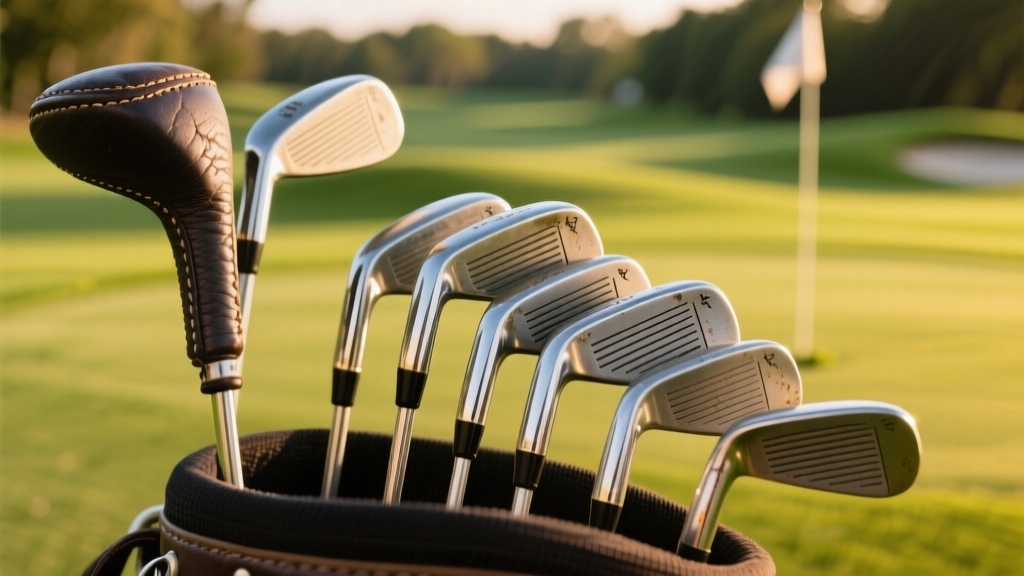You’ll find irons have narrower, less cambered soles designed for precision and longer distances, with a forward ball position and wider stance for stability. Wedges feature wider soles with varied bounce angles and grinds, optimizing spin and turf interaction for short-range, high-control shots.
They use a centered ball position and narrower stance. Swing speeds differ, with irons faster for mid- to long-range shots and wedges slower for finesse around the green. Exploring these contrasts reveals essential strategies for shot selection.
- Key Takeaways
- Club Design and Loft Differences
- Swing Mechanics and Approach Variations
- Purposes and Typical Use Cases
- Clubhead and Sole Interaction Characteristics
- Distance and Swing Speed Contrasts
- Setup and Stance Adjustments
- Frequently Asked Questions
- Transform Your Golf Performance with Better Club Knowledge
Key Takeaways
- Irons have narrower, less cambered soles designed for stability and longer approach shots; wedges feature wider, specialized soles for turf versatility and short-game precision.
- Wedges possess higher bounce angles (4°–14°) for improved turf and sand interaction, while irons have lower bounce (2°–8°) aiding consistent full-swing turf contact.
- Iron swings are longer, faster, and focused on distance control; wedge swings are shorter, controlled, and emphasize accuracy and spin.
- Setup for irons includes a wider stance and forward ball position for descending strikes; wedges use a narrower stance with centered or slightly back ball position for high loft shots.
- Irons are lighter with balanced weight distribution for mid-to-long-range shots; wedges have heavier, low-centered heads optimized for finesse and short-range shot adaptability.
Club Design and Loft Differences

When you examine club design and loft differences, you’ll notice that wedges and irons serve distinct purposes shaped by their specific loft angles and sole configurations. Pitching wedges carry lofts between 44° and 48°, resembling irons with narrow soles and low bounce for clean turf contact and longer approach shots.
Gap wedges bridge lofts from 48° to 54°, filling distance gaps with slightly wider soles. Grip size and feel, such as choosing between 58r and 60r grips, can also influence a player’s comfort and control with these clubs.
Sand wedges, with lofts of 54° to 58°, feature wider, rounded soles and higher bounce (10° to 14°) to prevent digging in bunkers. Lob wedges top out at 58° to 64°, often combining high loft with reduced bounce and specialized sole grinds to execute delicate, high-trajectory shots near greens.
These loft and sole characteristics provide precise control over launch angle, spin, and distance, differentiating wedges from standard irons. Additionally, the complexity and variety of iron designs mean that wedges, while specialized, fit within a broad spectrum of club types aimed at diverse player needs.
Swing Mechanics and Approach Variations
You adjust swing length and speed considerably between irons and wedges to optimize control and distance. Wedges require shorter, smoother swings, while irons demand longer, more powerful motions. The downswing sequence remains consistent, involving pressure shift, hip unwind, and chest rotation, but is adapted in speed and length to suit the club.
Your weight distribution and stance also shift subtly. Wedges favor a more centered or slightly forward setup for precision, whereas irons benefit from a balanced, forward-leaning posture to maximize carry. Mastering these nuances ensures consistent contact and effective ball flight tailored to each club’s purpose.
Additionally, keeping your hands dry with golf grips drying techniques can improve grip stability and swing control during play.
Swing Length and Speed
Although irons and wedges share fundamental swing mechanics, their swing lengths and speeds differ markedly to meet distinct shot requirements. When you swing irons, you execute longer backswing arcs with fuller shoulder turns to generate higher speeds, averaging around 96 mph for a 4 iron, facilitating maximum distance.
Maintaining good balance throughout the swing is crucial to ensure consistency and solid contact. Understanding the gross score concept can help players appreciate how scoring reflects the outcome of these swings during play.
Conversely, wedges have shorter shafts and higher lofts, prompting you to adopt a shorter, controlled swing, typically around 79 mph, to prioritize accuracy and spin control. You consciously adjust swing length and speed based on shot context, using partial swings with wedges for finesse without altering basic mechanics.
Maintaining consistent tempo and rhythm across clubs ensures repeatability, but wedge swings often feature a held-off finish. This approach aligns with the three-quarter or 80% power swing recommended for wedges to improve precision.
This precision-focused approach with wedges contrasts with irons’ emphasis on carry distance and trajectory, reflecting their distinct roles in your short game versus full approach shots.
Weight Distribution and Stance
Because weight distribution and stance directly influence your swing mechanics, understanding their differences between irons and wedges is essential for shot execution.
Irons feature a balanced or slightly forward weight distribution, enabling a sweeping, powerful strike with a wider stance and forward ball position to maximize stability and weight transfer onto your lead foot. The overall weight of irons tends to be higher than wedges due to their longer shafts and lighter heads, which affects swing tempo and control. Incorporating dynamic warm-up exercises before play can help optimize muscle activation and consistency in these mechanics.
In contrast, wedges have heavier clubheads relative to length and heavier shafts, concentrating weight low and deep for control and precision. Your stance narrows with wedges, the ball shifts to center or slightly back, and you maintain more even weight distribution to promote a steeper swing arc for crisp, descending strikes.
Purposes and Typical Use Cases
When selecting clubs for various shots, understanding the distinct purposes and typical use cases of irons and wedges is essential. Irons serve as versatile tools for long to mid-range approach shots, offering controlled trajectories and moderate roll.
Their design often includes loft variation that balances distance and accuracy to suit different shot requirements. Unlike hybrids or woods, irons generally provide a good balance between control and distance, making them reliable for a wide range of lies and course conditions.
Choosing the right club means knowing when to use irons for distance and wedges for precision.
You’ll rely on mid-irons (5-7) for precise fairway or rough shots, tee shots on short par-3s, and strategic ball advancement. Their lofts increase progressively to balance distance and control. Additionally, choosing the right iron length and shaft material can influence shot consistency and feel, similar to considerations golfers make between hybrids and woods.
Conversely, wedges specialize in short-range shots demanding high loft and spin to stop the ball quickly near the green. Use wedges for bunker exits, flop shots, chips, and delicate pitches requiring varied trajectories and minimal roll. Wedges also come with different bounce angles, which affect how they interact with turf and sand, allowing players to customize shots based on course conditions and lie.
Each wedge type addresses specific needs between roughly 85 to 115 yards, focusing on accuracy and control over distance, making them indispensable for scoring and short-game finesse. Their design prioritizes playability and shot accuracy much like the way hybrids offer better control from tricky lies compared to woods.
Clubhead and Sole Interaction Characteristics
You’ll notice wedges feature wider soles with varied grinds designed to optimize turf and sand interaction, while irons have narrower soles for precise contact on firmer lies. Understanding how sole design influences turf engagement is essential, as it directly affects shot consistency and control.
Additionally, bounce angle plays a critical role in preventing the club from digging too deeply, especially in softer conditions, making it a key factor in club selection. Wide soles lower mass in the sole area, which can increase launch angle and reduce spin, but they are less suited for tight turf conditions due to their impact on turf playability.
Wearing a golf glove on the lead hand improves grip stability and control during swings, which is essential when managing different turf interactions.
Sole Design Variations
Although irons and wedges share the fundamental goal of striking the ball cleanly, their sole designs differ markedly to optimize clubhead interaction with turf and sand. Irons feature solid, less cambered soles crafted primarily for stability and consistency, while wedges incorporate variable bounce angles and diverse sole grinds to enhance versatility and forgiveness in challenging lies.
The bounce angles in wedges can range from 4° to 14°, which significantly affects turf interaction and shot performance. This variation in sole design is similar in principle to how milled putters provide a consistent roll by lying flat on the turf.
| Feature | Irons | Wedges |
|---|---|---|
| Sole Shape | Solid, minimal camber | Varied camber, ribs, sole grinds |
| Bounce Angle | Low, fixed | Adjustable, 4°–14° |
| Forgiveness | Stability-focused | Designed for maximum forgiveness |
Turf Interaction Differences
Since turf interaction critically affects shot outcome, understanding how irons and wedges differ in clubhead and sole design is essential for optimizing your play.
Irons typically feature a rounded, wider sole that reduces turf drag, promoting forgiveness and consistent ball flight through balanced weight distribution. Their soles optimize a descending attack angle with a more evenly spread mass to enhance swing speed.
Additionally, the wider sole of irons helps prevent digging and improves turf interaction, which is particularly beneficial for golfers who take deep divots or play on soft courses. Golfers often wear one glove to improve grip and control when using irons, ensuring better contact with the turf.
In contrast, wedges prioritize precise turf control with narrower, angular soles incorporating heel and toe reliefs. These design elements allow you to manipulate the club’s interaction with varied turf conditions via specialized grinds, improving versatility. The wedge’s durability and concentrated weight near the face support higher lofts and spin control, demanding a more nuanced turf engagement.
Bounce Angle Importance
When selecting clubs for different shots, understanding bounce angle is essential because it directly affects how the clubhead interacts with turf and sand. Bounce angle—the angle between the leading edge and lowest sole point—controls digging and skidding, influencing shot consistency and turf engagement.
Consider how bounce angle can influence swing speed by affecting turf interaction and shot execution. Consider these key points:
- Irons have subtle bounce (2°–8°), optimizing full-swing turf interaction and preventing excessive digging. This bounce is integrated with sole design to aid in glide and impact dynamics.
- Wedges feature pronounced bounce (4°–14°), tailored by grind and shot type, crucial for short-game versatility.
- Higher bounce benefits steep swingers and soft conditions; lower bounce suits shallow swings and firm turf.
- Sole design and grind modify effective bounce, impacting how the club moves through turf and sand during impact.
Distance and Swing Speed Contrasts
Because swing speed directly influences how far you can hit the ball, understanding the distance and swing speed contrasts between irons and wedges is essential for optimizing your club selection. Selecting a golf ball with the appropriate compression rating can also improve energy transfer and consistency when using these clubs.
Irons like the 7-iron require faster swing speeds to achieve longer distances, typically 130 to 170+ yards, due to their lower loft and flatter ball flight. In contrast, wedges with lofts between 45 and 60 degrees demand slower, more controlled swings that prioritize precision over distance, carrying between 50 and 140 yards depending on the wedge type.
Distance gaps between wedges and irons can vary significantly based on loft and player skill level. Your swing speed with wedges is deliberately reduced to maintain consistent trajectory and spin, while irons benefit from fuller swings to maximize yardage.
Setup and Stance Adjustments

Although irons and wedges share similarities in setup, key adjustments in ball position, stance width, and hand placement distinguish their effective use. You must tailor these elements to optimize control and consistency.
- Position the ball more forward in your stance for irons, near the lead foot, to promote a descending strike. Wedges require a middle-of-stance ball position for precise, low-flight shots.
- Use a narrower stance for wedges, often slightly narrower than irons, with a slightly flared lead foot to facilitate rotation and face control. For wedges, placing more weight forward (about 60%) helps achieve better control and consistent contact.
- Place your hands off the lead hip for irons, encouraging compression. For wedges, center your hands with the ball to enable clean contact.
- Maintain a moderate forward spine tilt in both, with a slightly steeper angle for wedges to support a steeper, controlled strike. Consistent grip pressure across all clubs is essential to maintain a solid foundation and confidence during setup and swing.
Frequently Asked Questions
How Do Irons and Wedges Differ in Maintenance and Cleaning?
You’ll need to clean wedges more often than irons since their grooves wear faster and impact spin greatly. Use a groove brush and warm soapy water to remove debris, focusing on wedges after every round.
Irons require less frequent cleaning and less groove sharpening. Always dry clubs thoroughly to prevent rust. Regular groove inspection is critical to sustain wedge performance, while irons mainly need cleanliness to ensure consistent shots and longer club life.
Are There Differences in Shaft Materials Between Irons and Wedges?
Think of shaft materials as the backbone of your swing. Yes, wedges usually sport heavier steel shafts, about 10-15 grams more than irons, to enhance control and feel during finesse shots. Irons might use graphite to reduce weight and vibration, but wedges stick mostly to steel for consistent turf interaction.
Matching shaft material and weight between your irons and wedges helps maintain consistent swing dynamics and tighter shot groupings, especially if you’re serious about precision.
How Does Weather Affect the Performance of Irons Versus Wedges?
You’ll notice cold weather shortens distances more for irons than wedges because denser air and reduced ball compression increase drag on longer flights. Rain and wet turf impact wedge control more, softening greens and bunkers, requiring technique adjustments.
Wind disrupts irons’ longer trajectories markedly, while wedges remain more stable but need controlled swings. High humidity and moisture challenge wedge grip and spin precision, so you should adjust grip pressure and club selection accordingly.
Can Beginners Use Wedges as Their Primary Short Game Clubs?
Think of wedges as your Swiss Army knife in the short game. They’re versatile and precise. Yes, you can absolutely use wedges as your primary short game clubs. Their higher lofts and ability to generate backspin offer you control on chips, pitches, and bunker shots.
By practicing consistent swing tempo and proper ball position, you’ll develop touch and distance control essential for lowering scores. Just be mindful not to rely solely on wedges for all distances.
Transform Your Golf Performance with Better Club Knowledge
When you step up to the ball, picture your irons as precision tools slicing through the air designed for controlled distance and trajectory. Wedges by contrast are your finesse instruments crafted for delicate touch and sharp spin around the green.
Understanding their distinct lofts swing mechanics and interaction with turf allows you to execute each shot with surgical accuracy. Mastering these differences sharpens your play turning every stroke into a calculated effective move.

